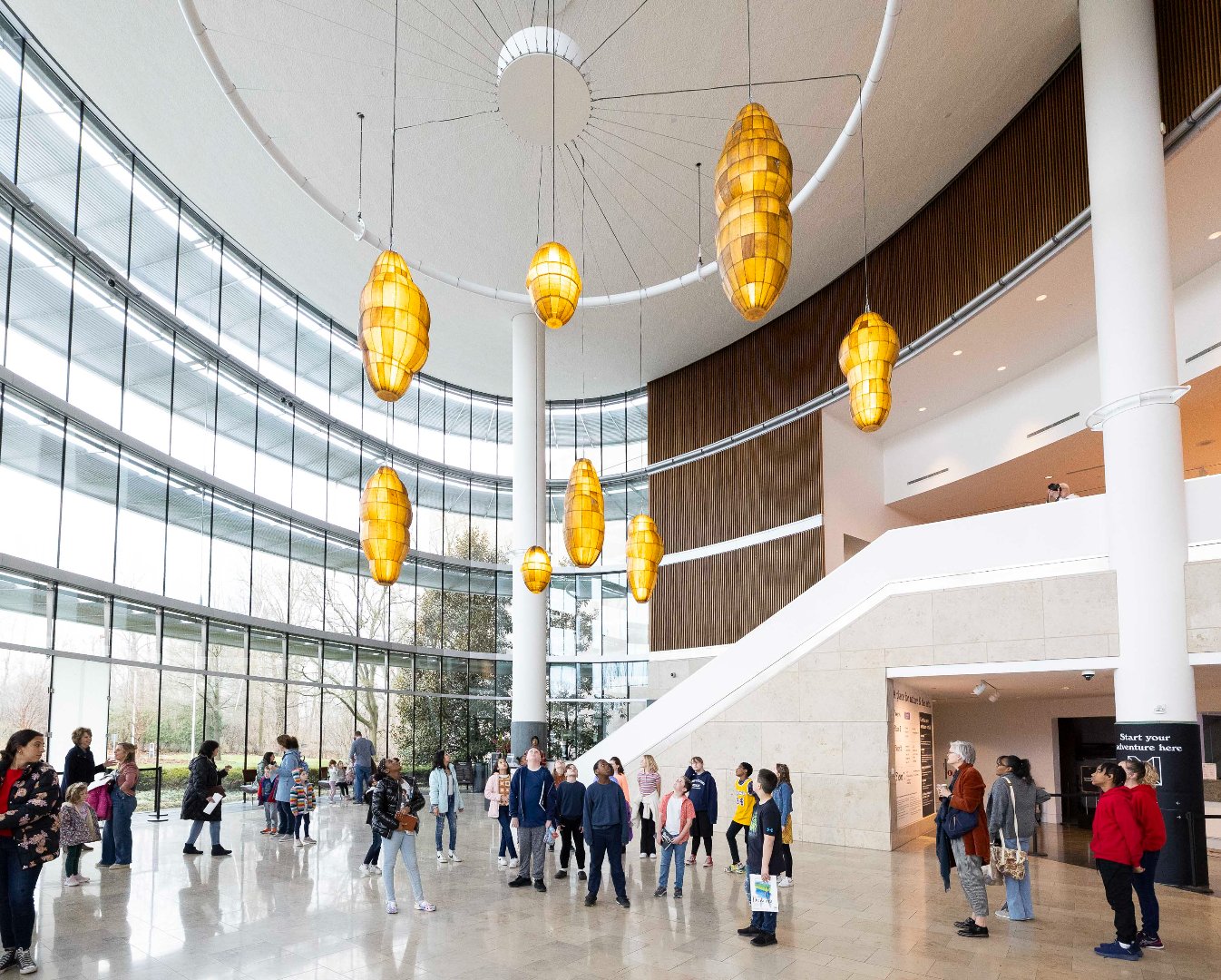Anicka Yi: A Natural Fit
Newfields’ mission is “to enrich lives with exceptional experiences with art and nature.” For the 2023 Efroymson Family Entrance Pavilion commission I wanted to highlight the connection between the Indianapolis Museum of Art and The Garden by selecting an artist who uses plant material as the media for their work. Anicka Yi is a highly experimental and conceptual artist who uses a number of unconventional materials in her practice, including paintings made from bacterial cultures and synthetic smells generated from organic sources.
For her installation at the IMA titled The Postnatal Egg, Yi has created a series of lamp sculptures constructed from lacquered kelp. This merging of art and nature encourages us to question dichotomies that we think of as fixed—natural and synthetic, human and machine, technology and biology. The experimental nature of Yi’s practice requires that she work in a highly collaborative way. This means not only engaging with scientists, biologists, perfumers, and architects, but also collaborating with artists and engineers within her own studio.
Yi employs a multitude of media in her works ranging from the familiar to the unusual. Flowers and soil represent the more usual, whereas bread dough, cow stomachs, and bacteria are more surprising choices. Though these materials often make Yi’s works visually striking, her practice places more focus on aspects of sensory experience that are usually overshadowed in the visual arts—smell, touch, and taste. Of these, Yi’s use of smell is the most radical and is her own feminist critique of the visual focus of the patriarchal art world. For Yi, eyesight and vision are associated with knowledge and power which are traditionally viewed as masculine, whereas the invisibility of scent imbues it with mystery and is therefore associated with the feminine. Though scent remains an important, albeit unseen, element of her work, Yi views scents as sculpture since the molecules that make up smells do take up physical space.
Yi expounded on this concept in her 2015 exhibition You Can Call Me F at The Kitchen in New York City, where she explored what she called the “patriarchal fear of the smell of women.” To accomplish this, Yi gathered swab samples of one hundred women in her personal and professional networks. Working with colleagues from the scientific community, these samples were then cultivated for a variety of uses within the exhibition. One of the uses for these samples was to create a scent for the exhibition itself. Once samples had matured in petri dishes, their molecules were analyzed for data that could be translated into mild scents. The resulting scents were then emitted into the exhibition space with diffusers. In this way, Yi subtly examines the power of the invisible.

For The Postnatal Egg, Yi sparks a conversation about the relationship between machine, nature, and biology. The piece consists of eight biomorphic kelp sculptures hanging at various heights. Their forms are organic in nature and recall gestating pupae, insect hives, and bodily organs. A soft glow emits from within, while animatronic insects flitting inside hint at an ambiguous symbiotic relationship. The ambiguity prompts a number of questions: is this form growing or decaying? Is the relationship between pod and insect mutually beneficial or parasitic? With this uncertainty, Yi asks us to examine ourselves as humans and our relationships to the ecosystems in which we live.
While these pods appear delicate, they are powerful. The use of kelp as a material calls attention to the history and potential of plants as the largest biomass on earth. The pods themselves are alive and will experience changes throughout the run of the exhibition. The kelp will fade from dark green to a pale yellow as it interacts with light in the environment. Condensation will gather in droplets on the surface of the sculptures in response to changing humidity levels in their environment. This piece was inspired by Yi’s concept of a primordial “meta-egg” capable of shifting between different species and life cycles, which she uses to conceive of each subsequent composition of kelp pods.
Yi’s use of unusual and seemingly incompatible media establishes her as one of the most imaginative and innovative artists of the last decade. In future work, Yi plans to apply these techniques to virtual and augmented reality to explore how it might be possible to incorporate diverse sensory landscapes, both human and unhuman, into the future of immersive technologies.
You can see Anicka Yi’s The Postnatal Egg in the Efroymson Family Entrance Pavilion at Newfields now through October 2023.
Exhibition Credits:
The Efroymson Contemporary Art Fund is an endowed fund that was established in 2006 by the Efroymson Family Fund to support work by emerging and established local, national, and international contemporary visual artists through a rotating installation program in the Efroymson Family Entrance Pavilion. Past artists and collectives whose work has been supported by the Fund include Allora & Calzadilla, Ball-Nogues Studio, Tony Feher, Spencer Finch, Friends with You, Orly Genger, William Lamson, Judith G. Levy, Mary Miss, Julian Opie, Heather Rowe, Alyson Shotz, Julianne Swartz, Sopheap Pich, Erwin Wurm, Richard Wentworth, Monika Sosnowska, Cracking Art, Studio DRIFT, Anders Herwald Ruhwald, and Anicka Yi.
Image Credits:
Anicka Yi (American, b. South Korea), The Postnatal Egg, 2023. Commissioned by the Indianapolis Museum of Art at Newfields. © Anicka Yi. Courtesy of the Artist and Gladstone Gallery.
Anicka Yi (American, b. South Korea), The Postnatal Egg, 2023. Commissioned by the Indianapolis Museum of Art at Newfields. © Anicka Yi. Courtesy of the Artist and Gladstone Gallery.




